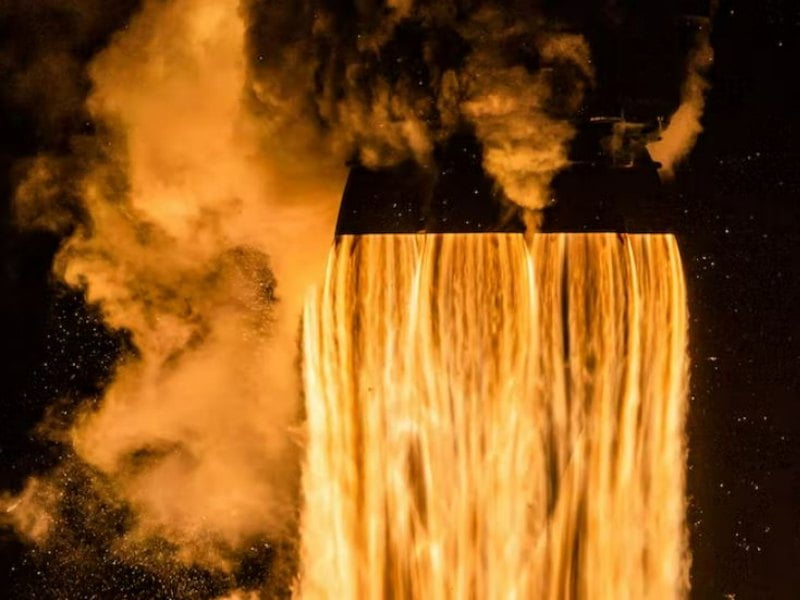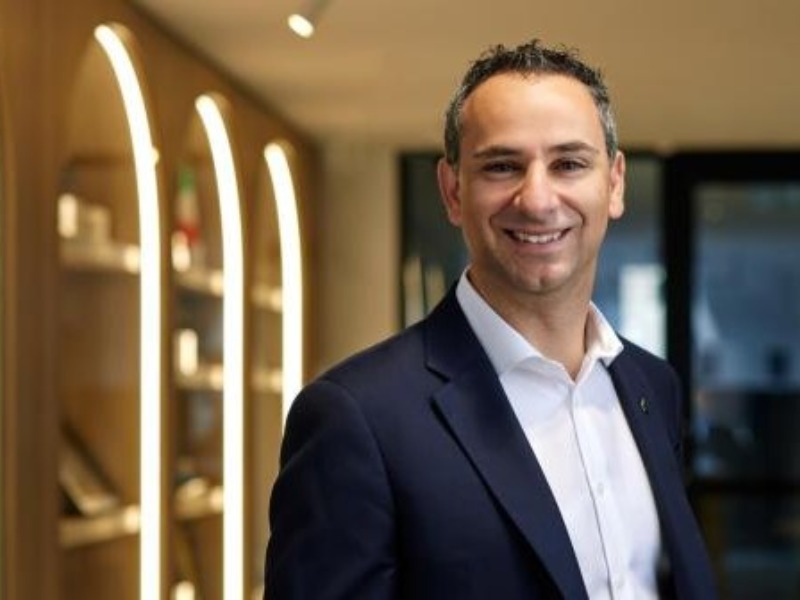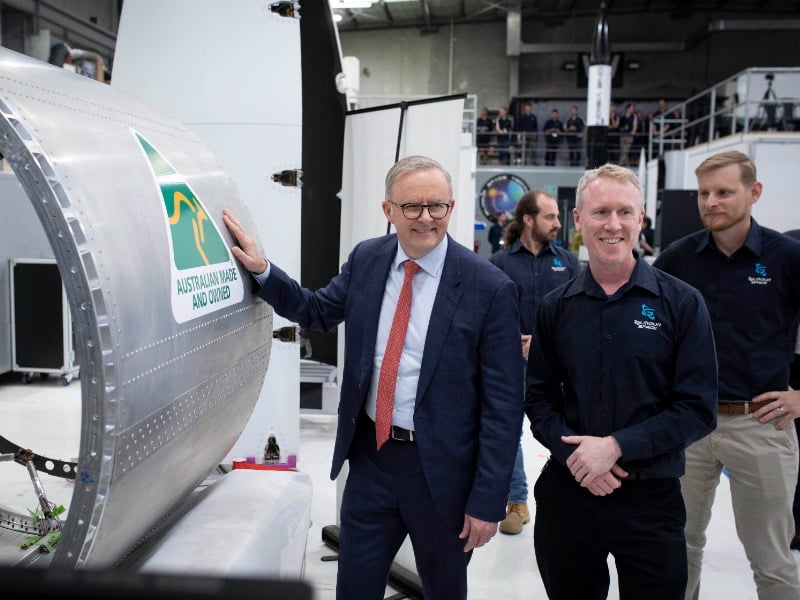What was supposed to have been a no-brainer treaty between the US and Australia promising to boost the local space industry – the Technology Safeguards Agreement – has instead developed into a public stoush over sovereign capability and control.
And the claimed economic benefit to Australia that would be delivered by the treaty has been pilloried as an illusion by the maverick CEO of Gold Coast-based orbital rocket manufacturer Gilmour Space Technologies, Adam Gilmour.
The Technology Safeguards Agreement, which was signed by the Prime Minister Anthony Albanese and US President Joe Biden at the White House last October, provides a framework that would enable US rockets to be launched from Australia.
The TSA also sets out the practical mechanisms that also allow US satellites to be launched from Australia, either on a US launch vehicle – that’s a rocket – or a non-US launch vehicle.
It similarly enables non-US spacecraft – that’s satellites and the like – to be launched from Australia as payload onboard US rockets.

If you own and operate a spaceport in Australia – and there are a few of these companies – then the TSA looks positive. Perhaps you’ll be managing the launch of a SpaceX or Blue Origin vehicle from your pad in the near future.
Satellite manufacturers might also now be looking forward to more choice and convenience in terms of launch vehicle and launch location.
But Gilmour Space Technologies, which also operates its own spaceport and has satellite manufacturing capability in-house, says the commercial opportunities are small and the broader economic benefits derived from the TSA are marginal.
There is no technology transfer through the treaty, and for spaceport operators the opportunity to value-add is tiny because Australians are locked out, precluded from any access to US-developed technology, from the ground systems to the rockets themselves.
Under the TSA, any US rocket being launched from Australia has to be manufactured in the US and largely assembled in the US. The vehicle integration work done in Australia has to be performed by US personnel from that US rocket maker in a segregated area with access restricted to US personnel only.
The strident criticism from Adam Gilmour must be difficult for this government to hear, given that he is the CEO of a sovereign prime manufacturer in an area of strategic national importance and the Prime Minister has made A Future Made in Australia a signature policy.
It is worth noting that the Gilmour Space launch vehicle was designed and built in this country – the rockets, the avionics, the fuselage – pretty much everything except the payload fairing (which is an off-the-shelf European component).
This means that none of the Gilmour Space launch vehicle relies on US technology or is ‘captured’ by US trade regulations such as ITAR (International Traffic in Arms Regulations) that are attached to rocketry and missiles.
This is a hugely important distinction and gives Australia sovereign control of the use of this technology. (There are many caveats here, as the only thing more complicated than rocket science are the national and multilateral treaties that regulate rocket technology).
But it is true. Australia has its own rocket technology developed independently of the US and outside of ITAR controls. The TSA specifically acknowledges that Australia is pursuing the development of its own launch technology (through Gilmour Space).
The Technology Safeguards Agreement is currently being considered by a joint parliamentary committee awaiting ratification, but is expected to come into effect later this year. Having been negotiated over two-and-half years, the process predates the Albanese government.
Industry and Science minister Ed Husic says the TSA is “a great deal” for Australia and for the local space sector, and says it is more favourable than other Technology Safeguard Agreements that the US has signed elsewhere in the world – most notably with the UK and New Zealand.
“The US demand for launch will increase investment in local infrastructure and scale the Australian launch sector. It will expand the market that is open to Australian companies and uplift the entire local space sector,” Mr Husic said.
“The TSA will unlock opportunities across the entire value chain for Australian organisations to deliver the innovations, data and knowledge from space that improve life here on Earth.
Mr Husic also said that a growing space ecosystem was an important part of the government’s critical tech agenda, which includes enhancing capability in robotics, artificial intelligence and quantum technologies.
Australian Space Agency chief executive Enrico Palermo told InnovationAus.com the treaty would deliver genuinely significant strategic and commercial benefits to Australia.
It unlocks access to the US space market – the largest in the world – and would enable whole new areas of commercial collaboration for Australian companies that would not have been possible without the agreement, he said.
While there are opportunities right now to expand launch services from Australia, Mr Palermo said the coming decade would also present opportunities for handling returns of US spacecraft.
This is a growing potential market given the advantages of space-based manufacturing for a niche collection of highly specialised products (like precision pharmaceuticals, or high-grade silicon wafers for the quantum industry).

Space Industry Association of Australia (SIAA) executive chair Jeremy Hallett said that while some parts of the sector would benefit more than others, on balance the TSA is very positive for the local industry.
“There’s huge demand for US launch to be done in other places other than the US. They really only have three main functioning spaceports, two on the east coast and one on the west coast,” Mr Hallett told InnovationAus.com.
“And the amount of launch activity going on in the US means that capacity is limited, not to mention their national security concerns around having a diversified and proliferated launch capability.”
For geographic, geopolitical and technical reasons, Australia has always been high on the list or potential options for US launch and return services, Mr Hallett said.
Australia is a close strategic partner, he says, we are in a geographically important (from a space point of view, if not geostrategic as well), and we have capability.
“The problem is the way the US likes to manage its risk with respect to certain arms control regimes, means that something like a TSA is necessary to establish that regulatory and legal environment to allow for the space flight of US technology from another nation.
“And so, for the purposes of enabling that to happen from Australia, I think the TSA achieves that purpose with the way it is worded. And the constraints that it places on enabling those activities are unsurprising.”
So, what’s the problem? Why the squeaky wheel from Gilmour Space in all of this?
Gilmour Space Technologies is Australia’s only sovereign orbital rocket company. In the coming weeks, the company will launch the maiden flight of its Eris vehicle from its Bowen Orbital Spaceport.
If Eris is successful – and it is likely that more than one flight for the three-stage vehicle will be needed to reach orbit – then Gilmour will have delivered to Australia a fundamental 21st century strategic capability: A sovereign ability to deliver payloads to space.
Of the Technology Safeguards Agreement, Adam Gilmour says quite simply that the treaty is a terrible deal for Australia. It is of limited commercial benefit that white ants the development of sovereign space companies.
In fact, he says, the TSA undermines not only the development of Australian technology but also cedes sovereign control of Australia’s access to space from our own territory to the United States.
The TSA does not enable technology transfer. On the contrary, it outlines a regime where the technology is locked down.
While strategic benefits are delivered to the US, there is little in it for Australia, he says.
And in a worst-case scenario – say, if the Australian government encourages US rocket launches from Australia by purchasing satellite launch services from US companies – the TSA would become the Trojan horse that could destroy this nascent Australian sovereign launch capability.

This is not fanciful. You don’t need an overly active imagination to see that if Gilmour were to get squashed – it doesn’t matter if its unintentional – that the easiest route to safety would be to shift headquarters to the US.
(If this were to happen, ironically, Gilmour would benefit from the existence of the TSA, which would enable it to launch rockets from Australia, but not to share its future technology developments with Australia).
Right now, Adam Gilmour and the Gilmour Space team are focused on its Eris test flight, which expected during April, but is pending a final launch permit from the Australian Space Agency.
Last month, Gilmour Space announced a Series D venture capital raise of $55 million which valued the company – which has yet to prove its Eris vehicle can reach orbit – at $605 million.
But there are two things that Gilmour Space can do that would instantly and dramatically increase the value of the company. The first would be a successful orbital flight for Eris, proving it can deliver payloads to orbit.
The second would be for Gilmour to deliver a rocket to orbit and then set up a subsidiary in the US, seeking US investors. Once the shareholding of US investors tops 51 per cent, it is a US company and will be treated as such via US law.
This would give the company access to US government contracts (and, also heavy with irony, it would probably give the company a better chance of winning Australian government contracts as well).
Gilmour would instantly become another player in a launch market struggling to meet demand, albeit one with its own spaceport near Bowen and production facilities on the Gold Coast.
This would be a shocking outcome and you would have to think that the Australian government would be working hard to make sure this did not happen.
It is worth remembering that RocketLab, founded by New Zealand commercial launch pioneer Peter Beck, had successfully sent payloads to orbit from a spaceport near Auckland, but growing venture capital dollars from US investors meant it became a US company and moved its headquarters to California.
RocketLab still launches some flights from New Zealand, but it does this as a US company. This is only possible because the New Zealand government quickly signed its own Technology Safeguard Agreement with the US, to protect the hundreds of high-value jobs in aerospace and manufacturing that had grown up around the company.
The New Zealand-US TSA includes a quite onerous commitment. The New Zealand government had to give the US government assurances that it was not developing or seeking to acquire any Missile Technology Control Regime (MTCR) category 1 rocket systems and would not do so into the future without first consulting with the US government. There is a sovereignty issue here.
The Australia-US TSA does not include this condition. But it does illustrate how New Zealand’s rocket technology and sovereign access to space came about through the singular drive of an entrepreneur.
But whether it could be retained as a sovereign capability would always have been dependent on the actions of its government.
This is where Australia finds itself right now.
The reality is that the US government protects its launch vehicle companies by law. The US government is mandated to use US launch vehicles operated by US companies.
The Australian government does not mandate the use of an Australian launch vehicle for the obvious reason that an Australian launch option did not exist. With Gilmour’s progress, this seems likely to change.
Adam Gilmour’s great fear is that the federal government, in a rush to encourage US rocket companies to come to Australia to help boost activity in the local space sector, will buy launch services from US rocket companies.
This is a rational fear, given the government’s track record of cultural cringe in procurement decisions, preferencing foreign-based multinationals, most notably in information technology.
The current stoush over the TSA also comes at a time when the federal government is redefining the word ‘sovereign’ in relation to capability.
In launching the Defence Industry Development Strategy last month, Defence Industry minister Pat Conroy said any area where Australia has both a domestic capability and control of supply chain should be considered ‘sovereign’.
So, the manufacture of Australia’s heroic Bushmaster armoured vehicle in Geelong – by the French multinational Thales – is a sovereign capability, Minister Conroy says.
But what about a SpaceX rocket loaded up with Australian satellites being launched from Australia with a launch permit from the Australian Space Agency? Is that a sovereign capability?
That’s the fight that Adam Gilmour has been having since the TSA was signed last October. This issue has less to do with the TSA, and more to do with procurement culture within government and the definition of the word ‘sovereign’.
While the space sector is nominally being managed by the Industry portfolio, the powerful influences on things like the Technology Safeguards Agreement are applied from far outside the concerns of industry. Industry capability is one thing, but the needs of the alliance with the US is another altogether.
The Australian government maintains the TSA will strengthen our long-standing partnership by enabling the US to access space from Australia, allowing a close ally to manage capacity constraints in its commercial spaceports in the continental US.
Where the Australia-US TSA differs markedly from the one signed by New Zealand is that it clearly signals Australia’s intention to develop rockets and launch vehicles. It does not impose any limitations on the Australian government investing public money in the development of this technology.
The Australian Space Agency chief Enrico Palermo says the agreement gets the balance right between strategic considerations and for Australian industry.
“We, like the US, have shared values around our commitments under the MTCR [Missile Technology Control Regime] … and balancing with that [in a way that] would not restrict our growth or Australian decision-making,” Mr Palermo said.
“Ultimately, we feel like we got that balance right and have recommended the treaty for ratification.”
“But importantly, through those negotiations, we were able to maintain our sovereignty and decision-making, and maintain the ability for Australian companies to develop rockets.”
For Australia’s sovereign manufacturer of rocket technology, the proof of the pudding will be in the eating.
Do you know more? Contact James Riley via Email.

